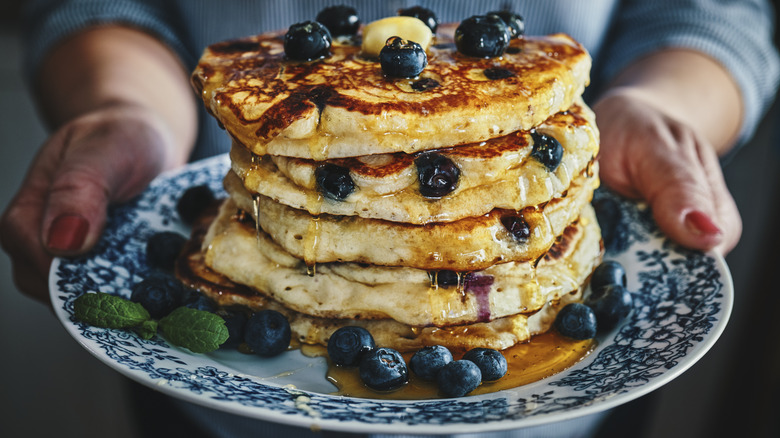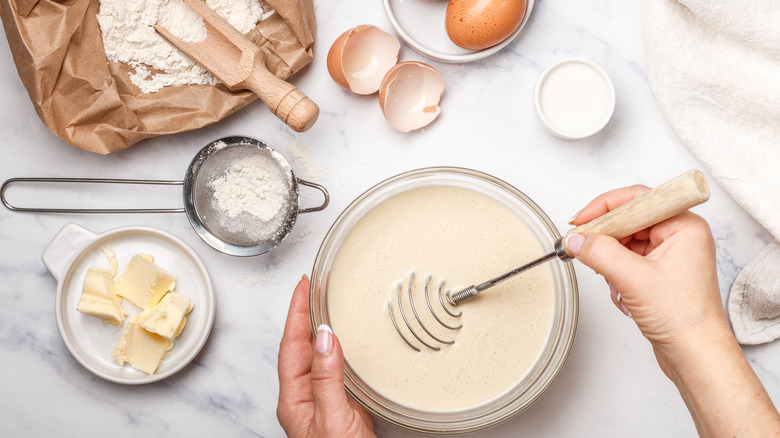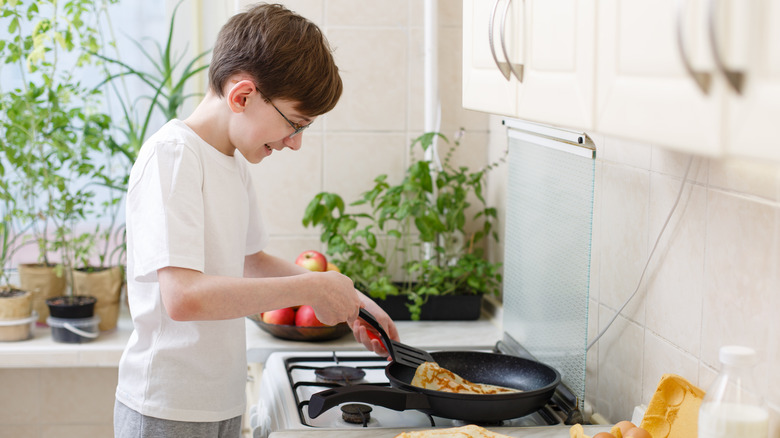That First Sacrificial Pancake Is Critical For A Perfect Batch
Pancakes aren't necessarily a difficult breakfast food to make, but there are some techniques when it comes to nailing that perfect batch. Of course, you can go the easy route and add a little water to a shake and pour mix (no judgment), but if you have the extra time, nothing beats from scratch classic homemade pancakes. To get that exterior crispy while keeping the interior soft, you need to make sure the pan is at the perfect temperature. Sometimes that means sacrificing the first pancake and using it as a way to test how hot the pan is — and how much butter you might need.
Pancake batter has a slightly sweet flavor, but it's the lightly caramelized exterior coupled with that fluffy bite that makes this dish so irresistible. Pouring some test batter means you can confirm three important aspects. First, whether the pan is at the right temperature to cook the pancakes properly. Second, whether all areas of the pan will cook evenly, and lastly, if the pan has enough butter or oil to make sure the pancakes won't stick.
Don't be afraid to sacrifice a little bit of batter
Not all stove tops are created equal, and cooking pancakes evenly can sometimes be difficult. By testing with a little batter, you'll know whether there are areas of the pan that don't cook as quickly as others. Knowing where these cool spots are will help you avoid uneven cooking or potentially burning your breakfast. With that, some pans are more nonstick than others, so you need to make sure you have enough butter (or another nonstick agent, like vegetable oil), in the pan to avoid a potential mess. If that first bit of batter is flipped and removed with ease, then you're ready to go.
Testing with your pancake batter can also help you gauge how much it will spread. When pancakes are poured onto the pan, they spread out into a circular shape. But if the batter is too runny and the pan isn't hot enough, it can spread too far and too quickly, becoming much thinner than intended. Taking this first step helps you ensure your batter is the right consistency and your pan is the right heat, so you can achieve the desired thickness.
Other tips for making the best pancakes
There are plenty of pans to choose from in most kitchens, and while there are mixed reviews on which material is the best for cooking pancakes, a quality nonstick pan is non-negotiable. Flipping those pancakes will be impossible if they're stuck. Don't assume that a nonstick pan doesn't require any additional nonstick agent; pancakes are delicate and need that extra help to lift effortlessly. Vegetable oil (you can also use butter) should be added after the pan is heated and just before adding the batter, and it should be added again (moderately) in between batches.
The majority of the cooking will be done on the pancakes' first side. Before they're flipped, they should have bubbles on top, edges that are no longer glossy, and will be about two-thirds of the way done. This is where the proper heat level and pan material come into play — and why that first test batch is so important to understand cooking time. If have any leftover pancake batter, you can store it in the refrigerator until the next day; if you want to store it longer, you're better off cooking the pancakes and refrigerating or freezing them to reheat later.


